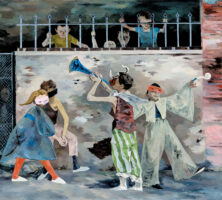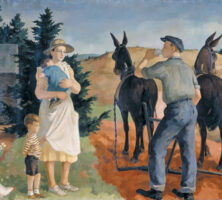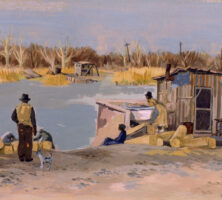Andree Ruellan, a New York native of French descent, was a prominent artist of the twentieth century. Although she worked primarily in New York and Europe during her long career, Ruellan’s frequent trips to the South, including to Savannah, provided her with rich source material. Her mural Spring in Georgia was installed at the post office in Lawrenceville in 1942 and is housed today at the R. G. Stephens Federal Building in Athens.
The Georgia Museum of Art in Athens mounted two solo traveling exhibitions of Ruellan’s work, the first one in 1993. The second exhibition, in 2005-6, was organized in celebration of the artist’s 100th birthday.
Early Life and Education
Ruellan was born on April 6, 1905, in New York City to Lucette (or Louise, according to some sources) Lambert and Andre Ruellan. Politically allied with the Socialist movement, her parents were ardent pacifists who left France in order for Ruellan’s father to avoid compulsory military service.

Courtesy of U.S. General Services Administration
Ruellan, who spoke only French as a young child, was encouraged by her parents when she displayed artistic ability. They sought the help of a family friend who augmented her education by taking her to museums, concerts, and cultural events, including the groundbreaking Armory Show in 1913, which introduced modern art to a wide American public. The following year, at the age of nine, Ruellan met Robert Henri and exhibited with him and the young realist painter George Bellows at St. Mark’s Church in the Bowery. Group exhibitions followed, and in April 1914 one of Ruellan’s illustrations was published in The Masses, a major left-wing magazine.
At the Art Students League in New York, Ruellan’s first instructor, sculptor Leo Lentelli, limited her to drawing from casts of antique sculpture, a conventional practice of the time, since her young age and gender precluded her from participating in the life-drawing class, where nude males served as models.
From 1922 to 1929 Ruellan and her mother lived in Europe. Ruellan studied in Rome, Italy, under Maurice Sterne, then in Paris, France, at the Academie Suedoise and the Academie de la Grande Chaumiere. This was a period of experimentation in the arts in Paris, and she developed a looser style that reflected the influence of Sterne, the modernists Pablo Picasso and Henri Matisse, and the artist Jules Pascin, well known for his shimmering line drawings. Her subject matter remained highly figurative, however, with frequent portrayals of friends, models, landscapes, cityscapes, and working-class people.

Courtesy of Morris Museum of Art
In 1925 the first one-person exhibition of her art took place at the Galerie Sacre du Printemps in Paris. Firmly ensconced in bohemian Paris with a wide circle of friends, Ruellan met artist John (Jack) Taylor in front of the American Express office, as both were on their way to a gallery opening of Pascin’s work. Three months later, in May 1929, they married.
In September 1929 Ruellan and Taylor, accompanied by her mother, made their home in Shady, New York, one of the hamlets of the Woodstock art colony, located 100 miles north of New York City. In addition to being an integral part of the art colony, they seasonally lived in New York City and occasionally took extended road trips, especially to the South. Ruellan put her changes in location to good use, sketching people and locales that interested her. She used a technique learned from Pascin for drawing on-site, hiding her materials in a newspaper or book so that she could capture her subjects freely. Sketches, pastels, and watercolors executed in this manner were used as the sources for finished paintings and prints completed in her Shady studio.
Southern Sojourns
In 1936 Ruellan visited Charleston, South Carolina, where the African American population of the city captured her attention. She sketched them working and enjoying leisurely activities along the waterfront and outdoor markets. For the next three years, Ruellan mined these sketches for subject matter.
In 1937 Ruellan became associated with the Maynard Walker Gallery in New York City. This gallery also showed the work of the leading American Scene painters Thomas Hart Benton, John Steuart Curry, and Grant Wood. Ruellan was reluctant to be labeled with these American regionalist painters since she felt that her work differed innately from theirs. Like them, she painted everyday subjects in a vital manner. However, her finished work emphasized solid forms and broad areas of color, emphases rooted in the modernist techniques she had encountered during her years in Paris. Further, she identified more with modernist sympathies than with the nationalistic spirit of the regionalists.

Courtesy of Columbus Museum. Museum purchase made possible by Norman S. Rothschild in honor of his parents, Aleen and Irwin B. Rothschild
In 1941, before the United States entered World War II (1941-45), Ruellan and her husband visited Savannah. While surreptitiously sketching, the couple was detained by the police, who suspected them of being spies. Their friend Alexander Brook, a prominent Woodstock artist who lived off and on in the southern city, vouched for them. In that same year, Ruellan received two commissions from the U.S. Treasury Department’s Section of Fine Arts to execute post office murals. The first one, A Country Saw Mill, was completed in 1941 for the post office in Emporia, Virginia. The following year, her mural Spring in Georgia was installed at the post office in Lawrenceville, in Gwinnett County. In both cases, she traveled to those communities in order to sketch scenes and then returned to her studio, where she created the large canvases that were later installed.
Ruellan visited New Orleans, Louisiana, in the late 1940s and early 1950s and again in 1956 and 1958-59, when her husband took teaching assignments at Tulane University in that city. During the earlier stays, Ruellan used their temporary residence in New Orleans to explore the city, sketchpad in hand. The mixture of French, Creole, African American, and Caribbean culture; the Mardi Gras rituals; the zoo; and the city’s iconic architecture were incorporated in her subsequent works. In the last visit of 1958-59, she learned sumi ink painting techniques; the fluidity of this technique ushered in a period of greater abstraction in Ruellan’s work, which continued to retain recognizable representational fragments.
Ruellan’s last prolonged stay in the South occurred when her husband took an assignment at the University of Florida in Gainesville in the early 1960s. There she sketched the birds and marshes of the area and based finished works on those sketches.
Later Years
In 1964, following nearly a year-long stay in France, Ruellan created a series of paintings based upon drawings she made there. She continued to paint and draw, and she took up making monotypes, a print process that supported the greater fluidity and spontaneity of her works during these years. Ruellan became increasingly active in the Woodstock Artists Association, particularly after the death of her husband in 1983. She died on July 15, 2006, in Kingston, New York.
Ruellan has received numerous awards and accolades. Her work is included in the collections of major museums throughout the country, as well as in many corporate and private collections.










